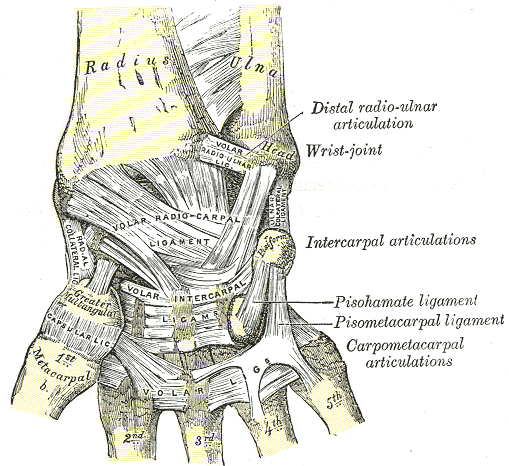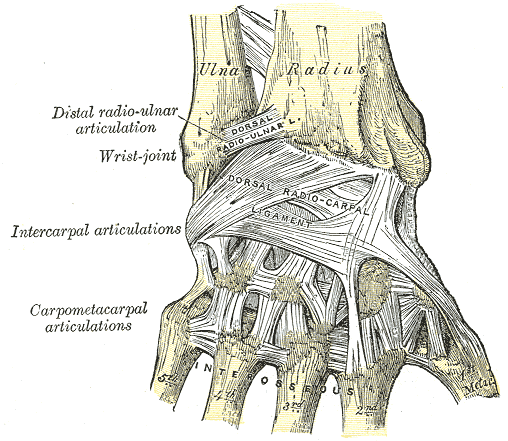[1]
Xiao K, Zhang J, Li T, Dong YL, Weng XS. Anatomy, definition, and treatment of the "terrible triad of the elbow" and contemplation of the rationality of this designation. Orthopaedic surgery. 2015 Feb:7(1):13-8. doi: 10.1111/os.12149. Epub
[PubMed PMID: 25708030]
[2]
LaStayo PC, Lee MJ. The forearm complex: anatomy, biomechanics and clinical considerations. Journal of hand therapy : official journal of the American Society of Hand Therapists. 2006 Apr-Jun:19(2):137-44
[PubMed PMID: 16713861]
[3]
Fliegel BE, Ekblad J, Varacallo M. Anatomy, Shoulder and Upper Limb, Elbow Annular Ligament. StatPearls. 2023 Jan:():
[PubMed PMID: 30860729]
[4]
Arias DG, Varacallo M. Anatomy, Shoulder and Upper Limb, Distal Radio-Ulnar Joint. StatPearls. 2023 Jan:():
[PubMed PMID: 31613500]
[5]
Stroyan M, Wilk KE. The functional anatomy of the elbow complex. The Journal of orthopaedic and sports physical therapy. 1993 Jun:17(6):279-88
[PubMed PMID: 8343787]
[7]
Al-Qattan MM, Yang Y, Kozin SH. Embryology of the upper limb. The Journal of hand surgery. 2009 Sep:34(7):1340-50. doi: 10.1016/j.jhsa.2009.06.013. Epub
[PubMed PMID: 19700076]
[8]
Mérida-Velasco JA, Sánchez-Montesinos I, Espín-Ferra J, Mérida-Velasco JR, Rodríguez-Vázquez JF, Jiménez-Collado J. Development of the human elbow joint. The Anatomical record. 2000 Feb 1:258(2):166-75
[PubMed PMID: 10645964]
[9]
Yang XH, Wei C, Li GP, Wang JJ, Zhao HT, Shi LT, Cao XY, Zhang YZ. Anatomical study of the anterior neurovascular interval approach to the elbow: observation of the neurovascular interval and relevant branches. Folia morphologica. 2020:79(2):387-394. doi: 10.5603/FM.a2019.0093. Epub 2019 Aug 26
[PubMed PMID: 31448401]
[10]
Yamaguchi K, Sweet FA, Bindra R, Morrey BF, Gelberman RH. The extraosseous and intraosseous arterial anatomy of the adult elbow. The Journal of bone and joint surgery. American volume. 1997 Nov:79(11):1653-62
[PubMed PMID: 9384425]
[11]
Nagpal P, Maller V, Garg G, Hedgire S, Khandelwal A, Kalva S, Steigner ML, Saboo SS. Upper Extremity Runoff: Pearls and Pitfalls in Computed Tomography Angiography and Magnetic Resonance Angiography. Current problems in diagnostic radiology. 2017 Mar-Apr:46(2):115-129. doi: 10.1067/j.cpradiol.2016.01.002. Epub 2016 Jan 27
[PubMed PMID: 26949062]
[12]
Ma CX, Pan WR, Liu ZA, Zeng FQ, Qiu ZQ, Liu MY. Deep lymphatic anatomy of the upper limb: An anatomical study and clinical implications. Annals of anatomy = Anatomischer Anzeiger : official organ of the Anatomische Gesellschaft. 2019 May:223():32-42. doi: 10.1016/j.aanat.2019.01.005. Epub 2019 Feb 1
[PubMed PMID: 30716466]
Level 2 (mid-level) evidence
[13]
Cavalheiro CS, Filho MR, Rozas J, Wey J, de Andrade AM, Caetano EB. Anatomical study on the innervation of the elbow capsule. Revista brasileira de ortopedia. 2015 Nov-Dec:50(6):673-9. doi: 10.1016/j.rboe.2015.10.001. Epub 2015 Oct 19
[PubMed PMID: 27218079]
[14]
Tagliafico AS, Bignotti B, Martinoli C. Elbow US: Anatomy, Variants, and Scanning Technique. Radiology. 2015 Jun:275(3):636-50. doi: 10.1148/radiol.2015141950. Epub
[PubMed PMID: 25997130]
[15]
Adams JE. Forearm Instability: Anatomy, Biomechanics, and Treatment Options. The Journal of hand surgery. 2017 Jan:42(1):47-52. doi: 10.1016/j.jhsa.2016.10.017. Epub
[PubMed PMID: 28052828]
[16]
Webb AL, Slome MC, Walker A, Ganti L. Radial Head Dislocation with Elbow Subluxation in an Adult. Cureus. 2019 Sep 5:11(9):e5570. doi: 10.7759/cureus.5570. Epub 2019 Sep 5
[PubMed PMID: 31695989]


